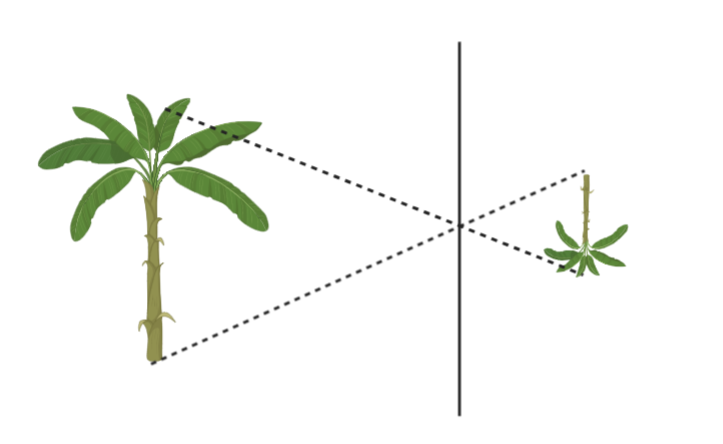
Images are inverted in a pinhole camera because:
(A) Light travels in a straight line
(B) Images are always inverted
(C) Images get inverted when light travel through a hole
(D) There is no specific reason
Answer
173.4k+ views
Hint An image formed by reflection can be real or virtual. A real image occurs when light rays actually intersect at the image, and become inverted, or turned upside down. A virtual image occurs when light rays do not actually meet at the image but appear to be met.
Complete step by step answer:
The light rays that come from the object get reflected from the plane mirror and reach our eyes. As they touch eyes our brain feels that the reflected ray is coming from inside the mirror. That is why the image of the object seems to be laterally inverted.

Such upside down inversion also occurs when you see yourself in a spoon on the concave side.
This phenomenon occurs obeying laws of reflection and laws of rectilinear propagation; which is light travels in a straight line.
Hence option A is correct.
Note Magnifying glasses are made of convex lenses. A convex lens can make objects look larger because it disperses the light. When objects are magnified, they are within the focal length of the magnifying glass. The focal length is defined as the distance between the center of the lens and its focus, the point where an object can be viewed clearly through a lens.
Complete step by step answer:
The light rays that come from the object get reflected from the plane mirror and reach our eyes. As they touch eyes our brain feels that the reflected ray is coming from inside the mirror. That is why the image of the object seems to be laterally inverted.

Such upside down inversion also occurs when you see yourself in a spoon on the concave side.
This phenomenon occurs obeying laws of reflection and laws of rectilinear propagation; which is light travels in a straight line.
Hence option A is correct.
Note Magnifying glasses are made of convex lenses. A convex lens can make objects look larger because it disperses the light. When objects are magnified, they are within the focal length of the magnifying glass. The focal length is defined as the distance between the center of the lens and its focus, the point where an object can be viewed clearly through a lens.
Recently Updated Pages
Matrices and Determinants Mock Test 2025 – Practice Questions & Answers

Permutations and Combinations Mock Test 2025 – Free Practice Quiz

Complex Numbers and Quadratic Equations Mock Test 2025-26

Sets, Relations, and Functions Mock Test 2025-26

Faraday's Law - Formula & Example

Molarity vs Molality: Definitions, Formulas & Key Differences

Trending doubts
JEE Main 2025 Session 2: Application Form (Out), Exam Dates (Released), Eligibility, & More

Displacement-Time Graph and Velocity-Time Graph for JEE

Uniform Acceleration

Electric field due to uniformly charged sphere class 12 physics JEE_Main

JEE Main 2025: Derivation of Equation of Trajectory in Physics

Atomic Structure - Electrons, Protons, Neutrons and Atomic Models

Other Pages
JEE Advanced Marks vs Ranks 2025: Understanding Category-wise Qualifying Marks and Previous Year Cut-offs

Learn About Angle Of Deviation In Prism: JEE Main Physics 2025

Enthalpy of Combustion with Examples for JEE

Instantaneous Velocity - Formula based Examples for JEE

JEE Advanced Weightage 2025 Chapter-Wise for Physics, Maths and Chemistry

Essential Derivations for CBSE Class 12 Physics: Stepwise & PDF Solutions




